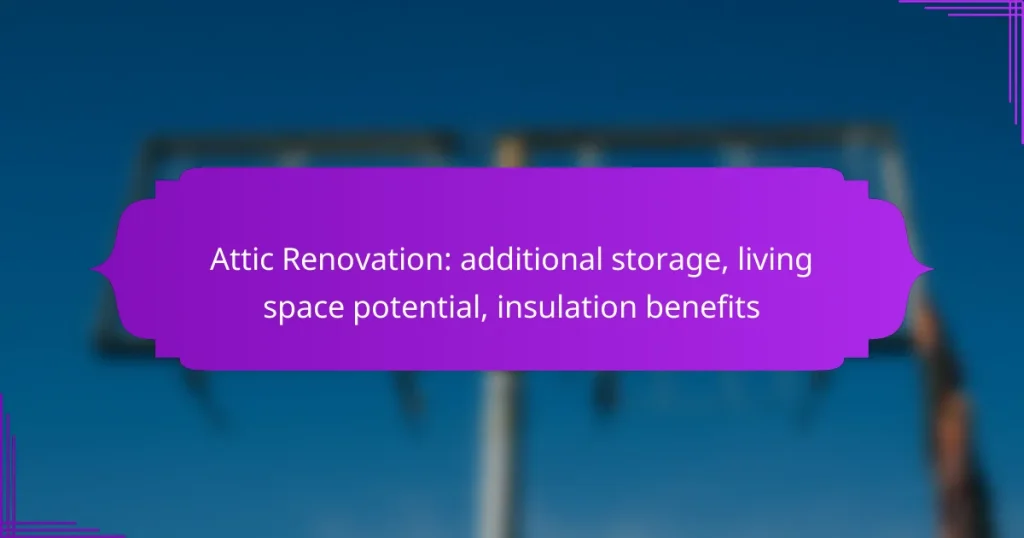Renovating your attic can transform it into a valuable asset for your home, providing additional storage, potential living space, and improved insulation. This project not only enhances organization and functionality but can also increase your property’s value and reduce energy costs. With thoughtful planning and design, your attic can become a versatile area that meets various needs.

What are the benefits of attic renovation in Canada?
Attic renovation in Canada offers multiple advantages, including increased storage, enhanced living space potential, and improved insulation. These benefits can lead to better home organization, greater property value, and reduced energy costs.
Increased storage space
Renovating your attic can significantly increase your home’s storage capacity. By transforming this often-underutilized area, you can create a dedicated space for seasonal items, holiday decorations, or other belongings that clutter your living areas.
Consider installing built-in shelving or storage units to maximize the available space. This can help keep your attic organized and make it easier to access items when needed.
Enhanced living space potential
An attic renovation can convert an unused space into a functional living area, such as a home office, guest room, or playroom. This not only enhances your home’s usability but can also increase its market value.
When planning this transformation, ensure that you comply with local building codes and zoning regulations. Proper insulation, ventilation, and natural light are crucial for creating a comfortable living environment.
Improved insulation and energy efficiency
Renovating your attic can lead to better insulation, which is essential for maintaining a comfortable temperature throughout your home. Upgrading insulation can help reduce heating and cooling costs, making your home more energy-efficient.
In Canada, where winters can be harsh, investing in high-quality insulation materials can yield significant long-term savings on energy bills. Consider consulting with a professional to assess your current insulation and recommend suitable upgrades.

How can I maximize storage in my attic?
Maximizing storage in your attic involves strategic organization and the use of space-efficient solutions. By implementing built-in shelving, installing pull-down stairs, and utilizing storage bins, you can create a functional storage area that meets your needs.
Utilizing built-in shelving
Built-in shelving is an effective way to maximize vertical space in your attic. By installing shelves along the walls, you can store items off the floor, making the area feel more spacious. Consider adjustable shelves to accommodate various item sizes.
When planning your shelving, ensure they are sturdy enough to hold heavier items like boxes or books. Using materials like plywood or metal can enhance durability. Aim for shelves that are at least 30 centimeters deep to hold larger containers securely.
Installing pull-down stairs
Pull-down stairs provide easy access to your attic without sacrificing floor space. They can be installed in a small opening, allowing you to keep the area tidy while still having convenient access to stored items. Ensure the stairs are rated for the weight you plan to carry up and down.
When selecting pull-down stairs, look for options that are insulated to help maintain your home’s energy efficiency. This can prevent heat loss in winter and keep your attic cooler in summer, contributing to overall comfort.
Using storage bins and organizers
Storage bins and organizers help keep your attic clutter-free and make it easier to find items. Opt for clear plastic bins to quickly identify contents, and label each bin for added convenience. Stackable bins can save space while maximizing storage capacity.
Consider using a mix of sizes for your bins to accommodate various items. For example, small bins can hold tools or seasonal decorations, while larger bins can store blankets or out-of-season clothing. Avoid overloading bins to prevent damage or difficulty in accessing items.

What are the costs associated with attic renovation in Canada?
The costs of attic renovation in Canada can vary significantly based on the scope of the project, materials used, and labor costs in your region. Homeowners can expect to spend anywhere from CAD 10,000 to CAD 50,000, depending on whether they are adding storage, creating living space, or enhancing insulation.
Average renovation costs
On average, attic renovations in Canada typically range from CAD 15,000 to CAD 30,000. This price range often includes basic upgrades such as insulation, flooring, and drywall installation. More extensive projects that involve structural changes or high-end finishes can push costs higher.
Factors influencing these costs include the size of the attic, the complexity of the renovation, and local labor rates. For instance, urban areas may have higher labor costs compared to rural regions.
Cost breakdown by project type
When renovating an attic, costs can be broken down by specific project types. For instance, adding insulation may cost between CAD 1,500 and CAD 3,500, while converting the attic into a livable space could range from CAD 20,000 to CAD 50,000. Basic storage solutions like shelving can be relatively inexpensive, often costing less than CAD 1,000.
It’s essential to consider not just the initial costs but also long-term benefits, such as energy savings from improved insulation or increased home value from a finished living space.
Financing options for renovations
Homeowners in Canada have several financing options for attic renovations. Common choices include home equity loans, personal loans, and renovation-specific financing programs. Home equity loans typically offer lower interest rates since they are secured by the home’s value.
Additionally, some provincial programs may provide grants or incentives for energy-efficient renovations, which can help offset costs. It’s advisable to research available options and consult with financial institutions to find the best fit for your renovation budget.

What are the best insulation options for attics?
The best insulation options for attics include fiberglass, spray foam, and cellulose insulation. Each type has unique properties and benefits that can enhance energy efficiency and comfort in your home.
Fiberglass insulation
Fiberglass insulation is one of the most common choices for attics due to its affordability and effectiveness. It typically comes in batts or rolls, making it easy to install between rafters and joists.
This type of insulation has a thermal resistance (R-value) ranging from about R-11 to R-38, depending on the thickness. When installing, ensure a snug fit to avoid gaps that can reduce efficiency.
Consider using faced fiberglass batts, which have a vapor barrier that helps prevent moisture issues in colder climates.
Spray foam insulation
Spray foam insulation provides excellent air sealing and has a high R-value, typically between R-30 and R-60. It expands upon application, filling gaps and cracks that other types may miss.
This insulation is particularly beneficial in attics with irregular shapes or hard-to-reach areas. However, it is generally more expensive than fiberglass and requires professional installation.
Keep in mind that spray foam can also act as a vapor barrier, which may be advantageous in certain climates but could require additional ventilation considerations.
Cellulose insulation
Cellulose insulation is made from recycled paper products and is treated for fire resistance. It is often blown into attics, making it a good option for filling voids and achieving a high R-value, typically around R-30 to R-60.
This eco-friendly option is effective at reducing air leakage and can help improve energy efficiency. However, it may settle over time, so proper installation is crucial to maintain its effectiveness.
When using cellulose, ensure that it is installed to the recommended depth to achieve optimal performance and consider adding a vapor barrier if moisture is a concern in your area.

What permits are required for attic renovations in Canada?
Attic renovations in Canada typically require several permits to ensure compliance with local building codes and safety regulations. The specific permits needed can vary by province and municipality, so it’s essential to check with local authorities before starting your project.
Building permits
Building permits are generally required for any structural changes made during an attic renovation. This includes modifications to walls, ceilings, or the roof structure. To obtain a building permit, you will usually need to submit detailed plans and specifications of the proposed work.
Costs for building permits can vary widely, often ranging from a few hundred to over a thousand Canadian dollars, depending on the complexity of the project and local fees. It’s advisable to apply for the permit well in advance of your planned start date to avoid delays.
Electrical permits
If your attic renovation includes electrical work, such as adding outlets or lighting, you will need an electrical permit. This ensures that all electrical installations meet safety standards and are inspected by a qualified professional. In many provinces, electrical permits must be obtained before any wiring work begins.
The cost for an electrical permit can vary, but it is typically less than a building permit. Always hire a licensed electrician for any electrical work to ensure compliance with local codes and safety standards.
Local zoning regulations
Local zoning regulations can affect what you can do with your attic space. These regulations dictate how properties can be used and may limit the type of renovations allowed, such as converting an attic into a living space. It’s crucial to review these regulations to ensure your plans align with local laws.
In some areas, you may need to apply for a zoning variance if your renovation does not comply with existing zoning laws. This process can take time and may involve public hearings, so plan accordingly. Checking with your local zoning office can provide clarity on any restrictions that may apply to your project.


